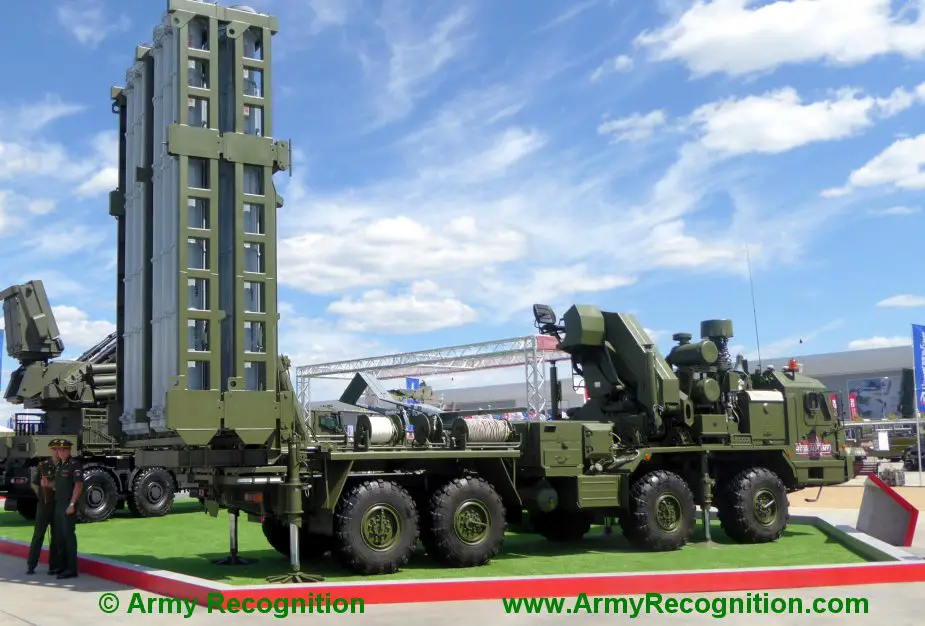Russian Defense ministry creates mobile air defense reserve
A major reform is in store for the national air defense. Each air force and defense army will get a mobile reserve comprising an air defense regiment. They will be created from scratch and armed with Pantsir missile guns. The new regiments will defend strategic facilities and reinforce available air defense units, the Izvestia daily said.

S-350 Vityaz air defense system displayed at Army 2019 (Picture source: Army Recognition)
The mobile reserve will fill in the gap in the defense and operate from ambush, former Deputy Commander of the Air Force of the united air defense of the CIS Lieutenant-General in Reserve Aitech Bizhev said. "The command has to use reconnaissance data to determine the level of threat and set the tasks to mobile air defense. Several positions will be prepared in peacetime. Standby positions for launchers will be arranged in several directions. They will accelerate deployment. Ambushes are usually arranged in ravines, along railroads or in river deltas which adversary aircraft can approach at minimal altitude and remain unnoticed for a long time," he said.
In a modern war, when air defense is incapable of protecting important facilities, the role of mobile reserves radically increases, expert Anton Lavrov said. He cited as an example the cruise missile strike at Shayrat airbase in April 2017. Reconnaissance reported the base was unprotected and the Americans delivered a strike at Syrian aircraft in hangars. "The Syrians lacked reserves to effectively ensure air defense of the base," he said.
Mobile air defense regiments can be redeployed in several hours to any part of the country and outside it. The Russian military acquired the necessary experience in the mid-2010s when they created air defense groups in Crimea in a very brief time, as well as in Syria.
The redeployment of S-300 battalion for the Syrian army in the autumn of 2018 offers an example of a rapid and covert operation. It was reported only after photos emerged in the Internet and showed the unloading of combat vehicles from airlifters.
The modern concept of mobile air defense brigades appeared in the early 1990s. Old antiaircraft S-75, S-125 and S-200 systems were not highly mobile and the air defense was built on the principle to protect facilities. The weapons defended specific cities, infrastructure, transport, industrial and military enterprises and units. The air defense could maneuver only in the limits of assigned positional areas. The tactic envisaged that after the first strike the air defense could move to standby positions to avoid being an easy target for an adversary strike.
Air defense reserve units appeared after the creation of S-300. They can be redeployed to major distances and prepared for launch. The first mobile formation was armed with highly mobile S-300PS, former Commander of antiaircraft missile troops Lieutenant-General Alexander Gorkov said.
"It was initially deployed in the Baltic region and developed into the 14th mobile air defense division which could rapidly advance towards Rzhev, Pskov or Veliky Novgorod and thus protect the northwestern direction from Moscow. The division was subordinated to the air defense commander-in-chief. The automatic system controlled all launchers from a single center. The formation had nine S-300 battalions which were a major force," he said.
The division was disbanded when the armed forces were cut several years later. The idea of a mobile air defense reserve reemerged in 2013 when the 1,721st antiaircraft missile regiment was created and armed with Pantsir-S and Buk-M2.
Pantsir can operate in tandem with various S-300 modifications, S-350 Vityaz and S-400 Triumph. The long-range weapons defend the most dangerous and distant facilities while Pantsir is in charge of drones, cruise missiles and guided projectiles in the close range.
Vityaz and Pantsir can be linked by automatic control to receive guidance and orders to fire from a single command post. The maneuvers to train the mission are already ongoing. In 2018, the latest antiaircraft systems held experimental tactical drills in the 185th training center of the Aerospace Forces at Ashuluk range in Astrakhan region. The task was to integrate S-400 Triumph and Pantsir-S into a single system and repel a massive strike. The possibility to unite various-class and range weapons was tested, the Izvestia said.
© Copyright 2019 TASS / Army Recognition Group SPRL. All rights reserved. This material may not be published, broadcast, rewritten or redistributed.




























